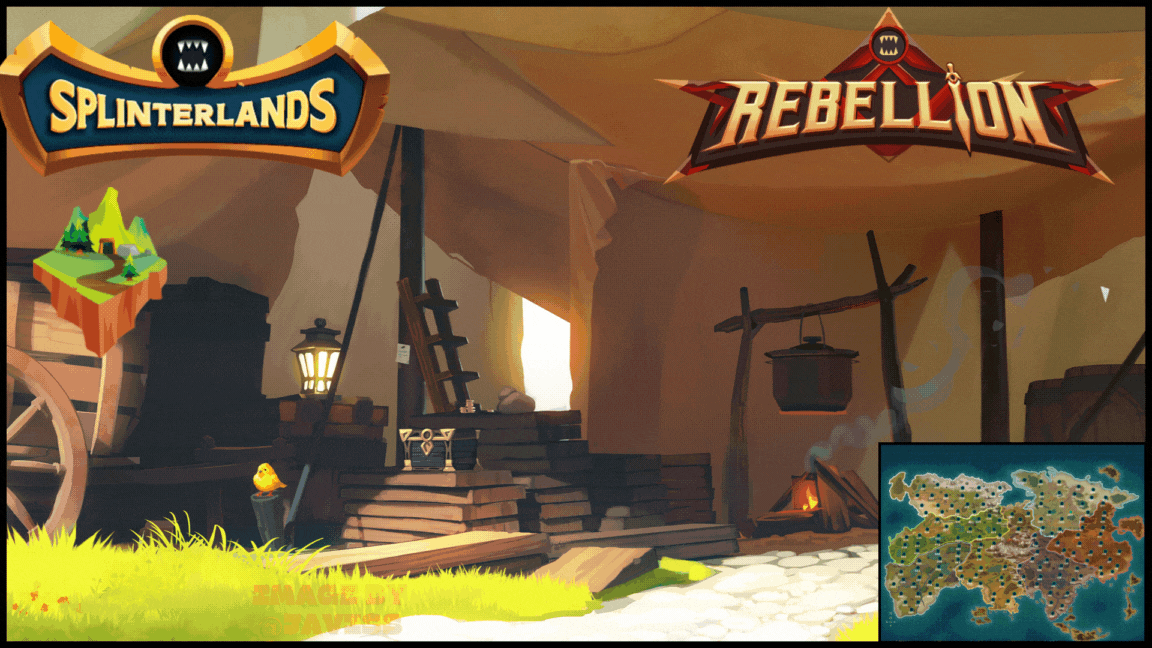
Introduction: Your Land Adventure Begins Here! 🚀

Hello, Splinterlands friends and family! 🎉 Today, as part of the Splinterlands Community Engagement Challenge: Support Articles, we’re diving into the exciting world of Splinterlands Land! 🌍
Personally, I ignored Land for a long time due to its high price, but about a month ago, I decided to invest in and work five plots. My primary motivation was the ranked bonus, though I also saw it as a long-term investment since land prices have become more affordable. 🏞️
The purpose of this guide is to cover the basics of setting up your land. We’ll go over surveying, resource management, and advanced strategies to maximize your plot's potential. Whether you're a seasoned player or new to the game, understanding Land mechanics will enhance your gameplay experience—yes, even if you don’t own any land yourself! 🌱
While many Land guides already exist, this one will focus on the practical aspects. We aim to walk you through what you need to do to start producing on your Land plots. Ready to get started? Let's go! 🔥

Step 1: Understanding Land Mechanics 🏞️
Owning land in Splinterlands adds a new layer of strategy, offering players unique opportunities for resource generation and gameplay enhancements. 🌿 Each plot of land can yield different resources based on its terrain type and the cards assigned to it.

Why Do We Want Land? 🤔
The primary appeal of land is that it will be the exclusive way to produce a future set of cards called items and spells 🔮, which will be essential in battles. Since the number of plots is fixed and will never increase, a growing player base could mean that there won’t be enough land for everyone. This scarcity will allow landowners to sell their production at potentially high prices, creating a lucrative opportunity! 💸
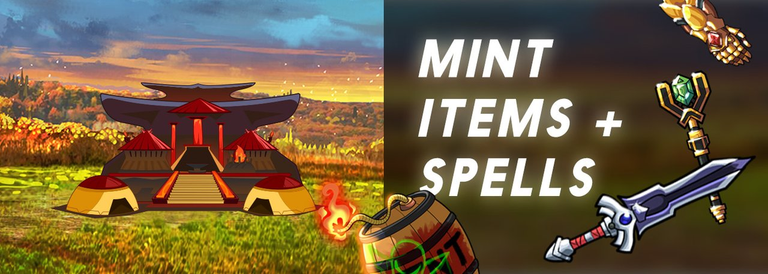
Types of Land 🏔️
In the world of Praetoria, players can own a piece of land with unique attributes and potential rewards. Praetoria is divided into 150 regions, each consisting of 1,000 land plots, making a total of 150,000 player-owned plots available.
- Plots: These are individual units of land, each with unique characteristics.
- Tracts: Areas consisting of multiple plots.
- Regions: Bigger areas containing multiple tracts and plots.
Each region is further organized into 10 tracts, while the regions themselves are grouped into 7 different territories—each containing between 20 and 22 regions. This structured layout provides players with a variety of landscapes and resources, adding layers of strategy in managing and optimizing land use.

Step 2: Claiming Your Land 📜🏷️
In Praetoria, land ownership is represented by Land Deeds, which are NFTs on the Hive blockchain. Players can acquire deeds by purchasing them from other players or redeeming claim tokens. 🌐
Claim Tokens 🪙
Claim tokens, originally sold by early explorers to fund expeditions, come in three types:
- PLOT: Claims 1 plot.
- TRACT: Claims 100 connected plots within the same tract.
- REGION: Claims 1,000 connected plots in a single region.
These tokens are tradable and have been actively bought and sold over time. By December 2022, players could redeem tokens for unsurveyed Land Deeds. 🏷️
Land Claiming Process 🏕️
To claim land, players can convert REGION, TRACT, or PLOT tokens into unsurveyed deeds:
- REGION tokens yield 1,000 consecutive plots.
- TRACT tokens yield 100 consecutive plots.
- PLOT tokens yield a single plot.
Claims start in Region 001 in the Pristine Northwest (PNW) and continue up to Region 150. When redeeming tokens, the algorithm assigns deeds based on the next available plot, tract, or region. Multiple tokens of the same type can be redeemed in one transaction for grouped plots, though locations may vary if regions are partially claimed. 🌍
Attributes of Land Deeds 🔍
Each Land Deed NFT has unique attributes:
- Territory
- Region
- Tract
- Plot
Land deeds are either unsurveyed or surveyed. In the unsurveyed state, only the basic location is known. After surveying, the deed updates to reveal full details about the land. 🗺️ Players can monitor the land claim screen to check the next available regions, tracts, and plots, though claims are processed in blockchain order.
For more on surveying and revealed attributes, check out the Surveying section below! 📖

Step 3: Surveying Your Land 🔍
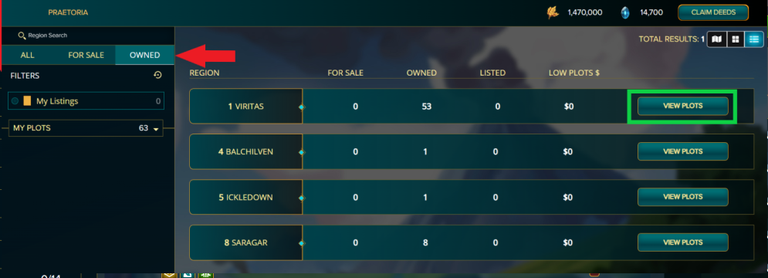
As expeditions into Praetoria progress, players need to survey their plots to uncover detailed information about them. By surveying unsurveyed land deeds (from PLOT, TRACT, or REGION tokens), players can convert these into surveyed deeds. Surveying reveals a plot’s:
- Terrain Type: Each plot has one of 14 terrain types (e.g., Badlands, Forest, Lake). Terrain affects which worker cards perform best and the types of resources available. 🏞️
- Rarity: Plots come in four rarities—Common, Rare, Epic, or Legendary. Rarer plots offer more resources and higher production rates. 🌟
- Resource Type: Plots can have Natural, Magical, or Occupied resources, with special bonuses for Magical and Occupied plots. 💎
Castles & Keeps 🏰
Each tract (100 plots) contains either a Castle or Keep. These pre-built structures act as vital hubs, allowing owners to collect taxes and fees from other plots in the area. Each region has 9 Keeps and 1 Castle, making these plots highly valuable. 💰
Surveying Probabilities & Guarantees 🎲
When surveying, players are guaranteed a minimum number of each rarity and type when surveying 100 plots at once. These rarities and types can overlap (e.g., a Legendary plot with a Magical resource type). While this guide doesn’t dive deep into these probabilities, you can find more detailed information on the Splinterlands Support Page. 📖
Starter Packages 🧰

When acquiring a plot, it's important to note that some may come with a starter package. Upon surveying land, players had the option to purchase three starter packages (10,000 DEC/DEC-B each) per deed for a competitive edge in future game phases. These packages were available only for a limited time and included:
Building in a Box 🏗️ - Start constructing a level 1 building instantly without spending resources. This package also includes a non-transferable Power Source for use on the associated plot.
Since the power core cant be transferred it will stay on the original owners account and wont pass to you even if you buy a plot with this package.Time Vault ⏳ - Provides 150 Time Crystals (for speeding up land clearing and future builds) and 15,000 Grain for resource production. These tokens are fully transferable.
Unstable Totem ⚡ - Doubles plot production for 30 days starting with Phase 2. The totem is linked to the specific plot and is non-transferable.

Step 4: Getting Your Plots Ready 🌱
To prepare your plots for productivity, you'll need three main components:
A. Workers: Staking Cards 🔒
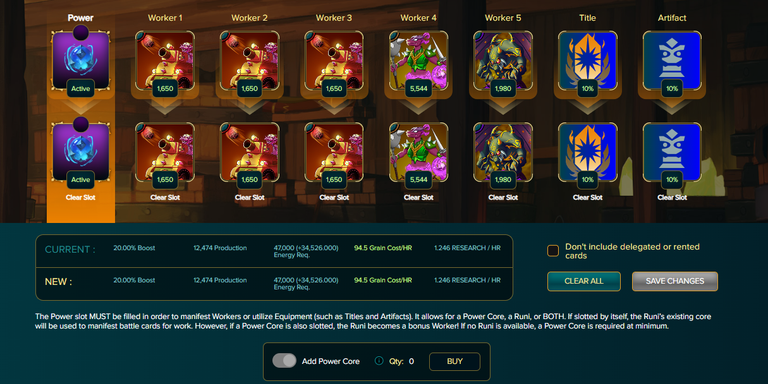
The first step in setting up your land is assigning workers to it.
In Splinterlands, you can stake up to 5 cards per plot to act as "workers" for building and resource production. Staked cards must be locked first (except for soulbound cards, which require DEC or VOUCHERS to "manifest" due to an SPS governance proposal).
Key points to remember about staked cards:
- Cannot be delegated, rented, unlocked, or used in battles while staked.
- Are instantly effective on land but require a 3-day unstaking period if removed, during which they can’t produce or be reassigned.
This staking feature is separate from the game’s existing "locking" system.
Production Points (PP) ⚙️
In Praetoria, resource generation and building construction are governed by a system of Production Points (PP). Each card staked on a plot contributes a specific amount of PP per hour, determining the efficiency of production activities.
Here’s a simplified overview of PP generation based on card rarity and foil:
| Rarity | Reg Max Lvl | Gold Max Lvl | Reg 1 BCX | Gold 1 BCX |
|---|---|---|---|---|
| Common | 1,000 | 2,000 | 2.50 | 52.63 |
| Rare | 1,100 | 4,000 | 9.57 | 181.82 |
| Epic | 1,250 | 6,000 | 27.17 | 600.00 |
| Legendary | 1,500 | 10,000 | 136.36 | 2,500.00 |
Older editions provide a multiplier effect, enhancing their PP contributions significantly. For example:
| Set | Editions | Base PP Multiplier |
|---|---|---|
| Alpha | Core, Promo | 10X |
| Beta | Core, Promo, Reward, Orb | 5X |
| Untamed | Core, Promo, Reward, Dice | 2X |
The game UI displays the exact PP contributions of each card, making it easy for players to experiment and optimize their card combinations without manual calculations.
Max Base Production Limit
A cap of 100,000 base production will be enforced on single plots starting in Phase 1.5, applying solely to base production values before any bonuses. Note that this limit does not apply to Runi.
Terrain Preferences 🏞️
When assigning cards to land plots, consider that specific elements get production bonuses on certain terrain types, while others incur penalties. Neutral cards can work on any terrain type without affecting production.
Below is a table listing the 14 terrain types and the production bonuses or penalties for each element:
| Terrain Type | Fire | Water | Life | Death | Earth | Dragon |
|---|---|---|---|---|---|---|
| Badlands | +10% | – | -50% | +10% | -50% | – |
| Bog | -50% | +10% | -50% | +10% | – | – |
| Caldera | +10% | – | – | -50% | -50% | +10% |
| Canyon | +10% | -50% | -50% | +10% | -50% | +10% |
| Desert | +10% | -50% | -50% | – | – | +10% |
| Forest | – | – | +10% | -50% | +10% | -50% |
| Hills | – | -50% | +10% | -50% | – | +10% |
| Jungle | – | – | +10% | -50% | +10% | -50% |
| Lake | -50% | +10% | – | – | +10% | -50% |
| Mountain | +10% | -50% | – | +10% | -50% | – |
| Plains | – | -50% | +10% | – | -50% | +10% |
| River | -50% | +10% | – | – | +10% | -50% |
| Swamp | -50% | +10% | -50% | +10% | – | – |
| Tundra | -50% | +10% | +10% | -50% | +10% | -50% |
Note: If no bonus or penalty is specified, cards of that element can work at the normal rate on that terrain. These bonuses or penalties apply to the base production of each card.
B. Power Sources ⚡
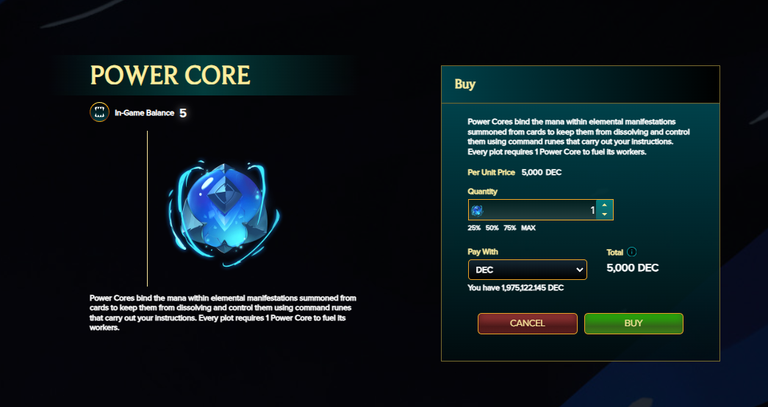

- "Building in a Box" starter packages included a Power Source, distributed on November 28, 2023. However, these Power Sources are not tradable; buying a plot with a starter package today won’t include a Power Source.
- Runi cards can also function as Power Sources, allowing an additional sixth card to be staked on plots with an existing Power Source.
C. Staking DEC 💰
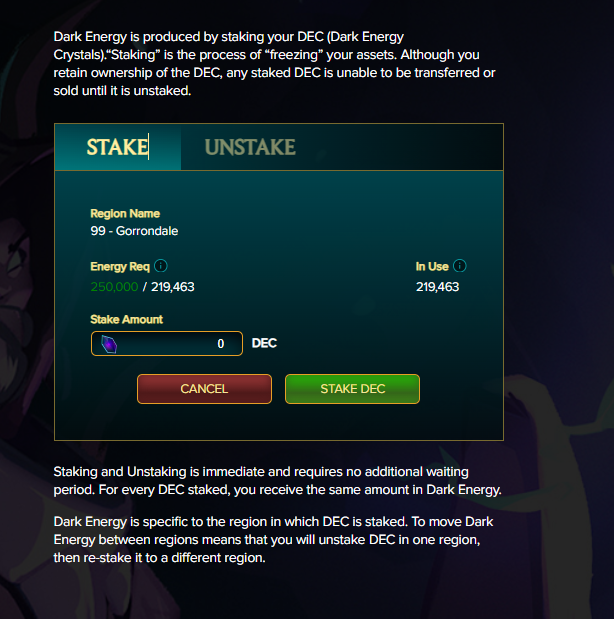
To maintain worker manifestations, Power Sources require Dark Energy Crystals (DEC) as fuel. Unlike burning, DEC must be staked, and only DEC tokens can be staked (not DEC-B).
Staking Requirements: 10,000 DEC per max-level card. Lower-level cards require less DEC, based on their BCX. For example:
- A 200 BCX Chaos Legion Common card requires 5,000 DEC.
- A 3 BCX Gold Foil Beta Legendary card requires 7,500 DEC.
Foil/Rarity Impact: The card's foil, rarity, or edition has no effect on DEC staking requirements.
Staking/Unstaking:
- Can be performed at any time with instant effect and no cooldown.
- Managed per Region, not per plot, meaning players must stake DEC for all plots within each region.
Production Impact:
- Total staked DEC is compared to the amount required by worker cards during harvesting. Insufficient staking reduces production. For example, with 10 plots and 5 max-level cards each, 500,000 DEC is required. If only 400,000 DEC is staked, production will be reduced to 80%.
Note: Staking or unstaking DEC triggers a harvest for all plots in that Region.

Step 5: Harvesting Your Land 🌾
Once everything is in place to start producing resources, your land will be ready for harvesting.
Workers produce resources continuously, but these only credit to a player's account upon harvesting—similar to claiming staking rewards for SPS. Players initiate a request on the Hive blockchain, which calculates the resources accumulated since the last harvest.
Harvesting Options 📈
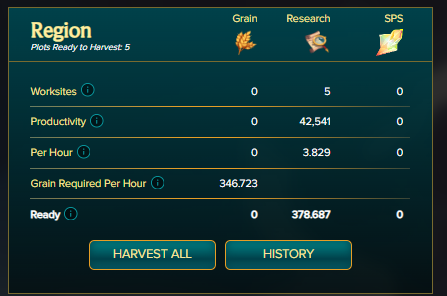
- Plot-by-Plot or Region Level: You can harvest resources from individual plots or from all plots within a region at once.
- Frequency: Harvesting can occur as often as once per hour or as infrequently as once a week. In phase 1.5, a 7-day limit will be introduced, meaning resources not harvested within this period will be lost.
Harvest Calculation 🔢
- Production Points (PP): The algorithm multiplies PP per hour by the number of hours since the last harvest.
- Resource Determination: Resources earned are calculated according to specific formulas for each type.
- DEC and Grain Check: Ensures there is enough DEC and Grain staked to meet worker needs. If resources are insufficient:
- The harvest output is reduced proportionally. For example, if only 75% of the required DEC is staked, the output will decrease by 25%.
- An optional setting allows auto-purchasing Grain at 1 DEC per unit if liquid DEC is available. If this option is disabled or funds are insufficient, the output will be reduced.
- When harvesting multiple plots, Grain-producing plots are harvested first to help cover food needs.
Auto-Harvests ⚙️

Any change that affects PP generation—such as staking/unstaking cards or using totems—will trigger an automatic harvest for that plot. Additionally, any changes in the total DEC staked within a region will trigger a harvest for all plots in that region to maintain consistent PP generation.
Important Tip: Before harvesting, always ensure you have enough Grain staked to support your workers otherwise you might lose production or overpaid for the grain!

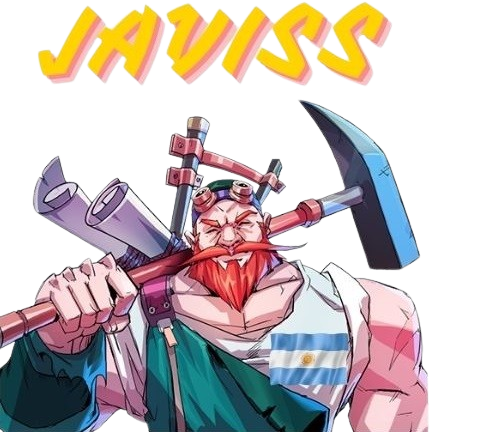
Conclusion 🌟
I aimed to keep this guide straightforward and practical, making it a valuable resource for new players looking to dive into Splinterlands Land. The goal was to present essential information without overwhelming readers with excessive details on land mechanics.
Throughout this guide, we learned how to quickly set up your land in a 5-step process. We explored key concepts such as staking cards, managing Power Sources, understanding DEC staking, and the intricacies of harvesting resources. We also covered terrain preferences and how different elements interact with various terrain types.
While there are many additional topics we could delve into—like production boosts, resource types, taxes, totems, titles, internal markets, and the future of land—my intention was to provide a solid foundation for understanding how to set up your land effectively.
I plan to explore these intriguing subjects in future posts, but for now, this is your essential guide to land setup!
Disclaimer 📜: Most images and animations in my posts are of my own creation, often made using Canva.com. Since I primarily use Splinterlands art and images, I don't claim proprietary ownership, so feel free to use them in your posts! I only ask that if you do, please tag me in your post, leave a comment, and perhaps vote on this post so I know the image is being reused. Thanks, everyone! 🙏
Check Out My Latest Posts! 🔗
If you'd like to see more content, you can check out my latest posts by clicking the images below!
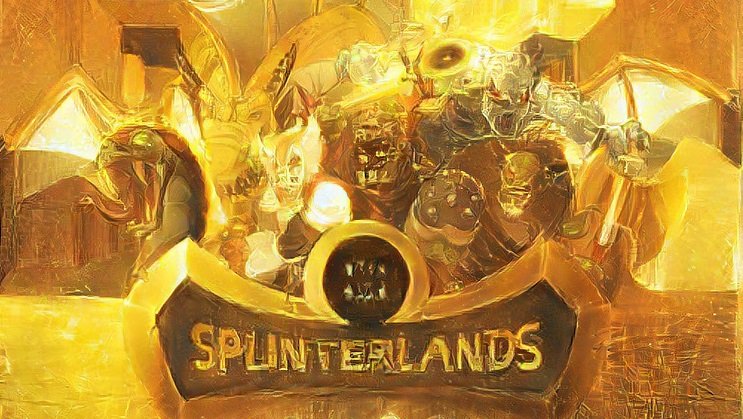
| SPLINTERLANDS.COM - Referral Link | SPLINTERSHARDS (SPS) | BLOG | DISCORD | TELEGRAM |
#splinterlands #play2earn #challenge
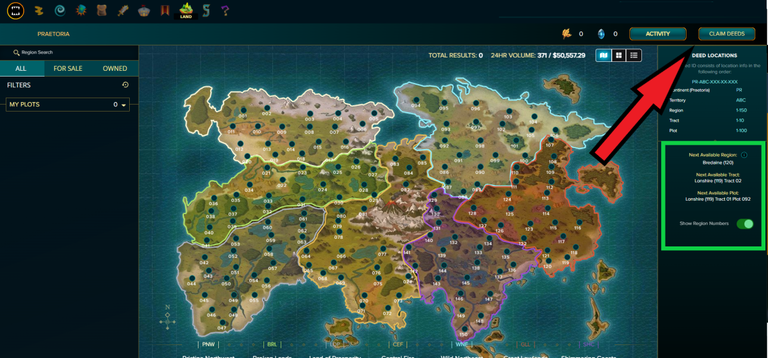
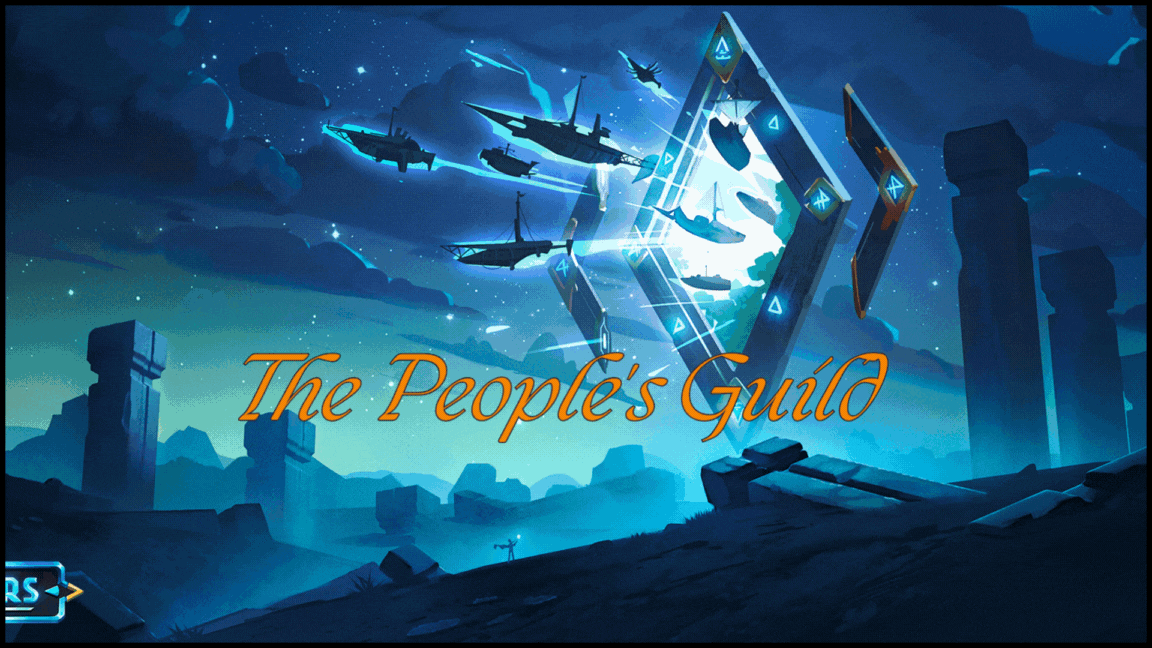


Thanks for sharing! - @yonilkar
